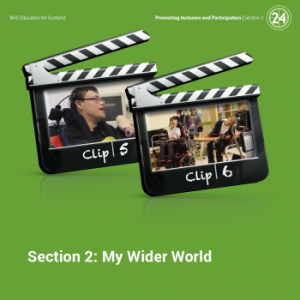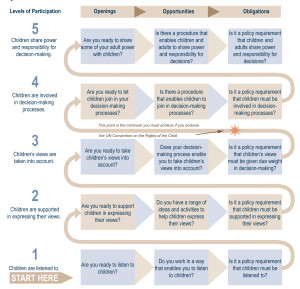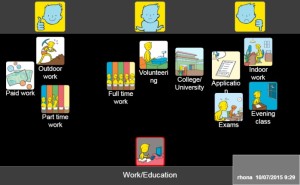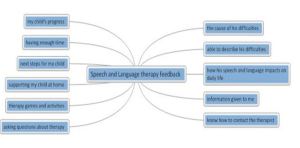Talking Mats was used as part of a Speech and Language therapy assessment for a boy with a stammer (dysfluent speech). He was very aware of his stammering and would change what he was going to say or avoid some situations because he anticipated that he would stammer. He had low self-esteem about his speech and felt that whenever anyone laughed in his class, it was to do with his stammer.
Talking Mats was used to gather information about which situations and people made speaking easier, and any situations and particular people which caused more of a challenge. The activity provided much more information than originally anticipated.
A starter mat was used to show how a Talking Mat worked, using pictures of food. He engaged well with this, and understood the process quickly. We then moved onto discussing his speech – we wrote names of people in his life and situations which involved speaking onto pieces of paper, and he placed these on the mat where he felt appropriate. We started with people and situations which appeared more positive, then gradually moved onto those it was anticipated would be more challenging.
His insight into his speech and what helped him or made speaking more difficult was impressive. We were able to use this information to compile a list of “Do’s and Don’t’s” for people he came into regular contact with. He agreed that this information could be shared with school to give them strategies to support him there.
The most powerful part of the Mat was him being able to say that he did not feel happy about talking with his big brother sometimes, because he could make fun of his speech, and this made him feel really upset. This was a powerful revelation for his Mum who had sat in on the session, as she had not realised he felt this way. After the session, the family had a chat around the table at tea-time about how his therapy session had gone that day – with Mum’s support he was able to say to his brother about how his teasing had made him feel. His older brother had thought it was all a bit of fun and hadn’t realised the impact it was having. They agreed the older brother wouldn’t tease him anymore.
When he came back for his next session, he commented on being much happier about his talking at home, and felt the activity had been really helpful. His Mum was very positive about it too, and proud of how he had managed to speak up for himself and be able to say how other people could help him with his talking.
Our thanks to Kirsten Taylor, Speech and Language therapist for sharing this powerful story
Do you want a part time, time limited opportunity to work for Talking Mats based in the North West of England? We are appointing an External Associate to extend access to resources and training in this part of the country. We would like this person to
- generate interest and business in the North West of England in Talking Mats with a focus on children and young people, particularly the promotion of the use of Talking Mats in the SEND(Special Educational Needs and Disability) reforms
- work with Talking Mats to promote a marketing seminar in the North West
- work with Talking Mats to run training and establish a base for a North West training programme
- increase sales in Talking Mats in the North West of England
If you have extensive experience of using Talking Mats to allow children and young person to have a voice particularly in their education, health and care plans and are passionate about extending the reach of this framework to a range of services then please consider whether this opportunity maybe right for you. We are looking for someone with initiative ,enthusiasm for the role of Talking Mats, good local professional networks and great communication and networking skills.
Please down load the person spec, project role and how to apply here Talking Mats External Associate
Closing date is the 28th Feb with interview scheduled for the 7th March .if you want to discuss further then please phone the Talking Mats office and ask to speak with either Lois or Margo.
What works well when implementing Talking Mats?
Our last blog highlight how the Wigan Pathfinder Project selected Talking Mats from a range of tools to consult with pupils who have Education, Health and Care plans (EHCP) . They reported that Talking mats provided :
- An objective, neutral space – a thinking tool- ‘Children and young people are able to consider their priorities when setting targets’.
- Opportunities for change – ‘Children and young people are able to make changes to their initial thoughts and have time to decide and reconsider options’.
- A truly person centred approach
- It was fun!
Additional factors they commented on which worked well when consulting with pupils about decision making and goal setting were:
- Good liaison with parents and staff who know the child well before the session
- Adapting the length of the session to the child’s needs
- Ensuring a suitable room without too many distractions
- Using the teaching scale
- Putting the child’s name on the mat
- Placing all topics in one envelope for easy access
- Allowing time to sort symbols and discard irrelevant ones.
- Reducing the number of symbols used depending on the child’s needs
- Changing the top scale symbols to support the child’s understanding where necessary
- Keeping a verbal record where appropriate
- Working in pairs whilst learning the approach
- Using the effectiveness coding framework (all case studies scored above 75%, therefore considered effective using this measure)
The Talking mats training focuses on teaching how to establish a consistent and appropriate top scale, maintaining a clear topic and using the effectiveness framework. It also presents a model for thinking about who can and cannot use the mat and for what types of questions and discussions
We are grateful to Emma Atkiss, one of our accredited trainers for this interesting report.
The purpose of The Voice of the Child pilot project carried out by the Wigan Pathfinder team was to obtain pupil views using a viable tool. The team selected Talking Mats as a framework to support pupils to express their views in decisions regarding their lives. They were working on the principle that engaging with the young person and his/her family would lead to better outcomes
The project team considered that Talking Mats met the 5 criteria of Shier’s model of participation (2001)
- Children are listened to.
- Children are supported in expressing their views.
- Children’s views are taken into account.
- Children are involved in the decision-making processes.
- Children share power and responsibility for decision-making.
Click on diagram to enlarge.
The pupils in the pilot ranged from 7 to 17 years with a range of disabilities. During the pupil interviews the team found that the Talking Mats Health and Well being resource provided a practical framework for decision making and target setting
Talking mats provided :
- An objective, neutral space – a thinking tool- ‘Children and young people are able to consider their priorities when setting targets’.
- Opportunities for change – ‘Children and young people are able to make changes to their initial thoughts and have time to decide and reconsider options’.
- A truly person centred approach
- It was fun!
For example : A seven year old child with Autistic Spectrum Disorder identified both her cognitive strengths and areas for development using the Learning and Thinking domain. She provided feedback regarding her difficulty in attending when faced with too much information or choice and also her strength in planning skills. Thinking skills targets and interventions can be developed using this information as a starting point.
Their report states that the information gained from Talking Mats can be used, as part of the Education Health and Care planning and review cycle, to inform both decision-making and goal setting for children and young people i.e. It identifies strengths; It identifies areas to develop; It identifies the child / young person’s response to a range of experiences; It informs day-to-day decision-making ; It informs both targets and interventions for Individual Education Plans and it supports transition planning.
Ref : Engaging the voice of the child / young person at an individual level – Emma Atkiss,Senior Educational Psychologist and Caroline Gomez, Educational Psychologist, Wigan council
The transition from children’s to adult health services for young people with exceptional needs and their families is complex, multifaceted and fraught with concerns and fears. CEN Scotland commissioned Talking Mats to carry out a study to collect the views of 10 young people and their families who are experiencing this transition in Scotland.
The families in the project have given us clear views about their problems and fears and also some thoughtful suggestions for what could be made better. It is often in making small changes that significant improvement can occur. These suggestions include:
- Courses for parents on transition
- More specialist nurses e.g. transition nurses, acute liaison learning disability nurses
- Start preparing early – at least 2 years
- Transition wards for young people
- Training for doctors and nurses about complex needs
- More respite, not less
- Emotional support for parents
- Longer appointment times
- A hotline to GPs
This study captures the complexity and variation of transition health services for young people with complex health needs from the perspective of both the young person and their parents. Despite the problems and fears we also saw evidence of good practice and suggestions, such as those above, which give hope for the way ahead.
To read the full report, including a moving case study, and direct comments from families, please click here CEN Transition Report
.
We are delighted that the free seminar we are holding in London on the 20th of October is now full, so have planned an additional session on the same day.
This is a great opportunity to find out about this communication tool which gives children and young people a voice. Children and young people are experts in their own lives and Talking Mats is a useful framework for enhancing participation and inclusion. It is suitable for a range of people who need support to express their views, interests and aspirations, and make decisions about their support. e.g. pupils with communication difficulties; pupils who have English as an additional language; and those who are reluctant communicators or who find it difficult to organise their thinking. We would particularly welcome staff from educational settings.
During the session we will
- Show examples of pupil participation
- Provide hands on experience of the Talking Mats resources, both original and digital
- Exchange practice and ideas
The seminar will be on the 20th October 2015 from 1.15 pm –3.00 pm and located close to London Bridge station.
To book a place contact info@talkingmats.com.
Places will be allocated on a first come first served basis.
The Children and Families Act 2014 makes clear that local authorities in England must have regard to the views, wishes and feelings of the young person and the parents. How do you ensure children and Young People are fully involved in decisions about their support and what they want to achieve? This blog describes how Talking Mats can be used to support the Education and Health Care Plans (EHCP).
A question like ‘What do you want to be able to do in the next 12 months, that you can’t do now ?’ is difficult for us all. For children and young people who struggle with communication, this is even more of a challenge.Talking Mats is an ideal tool to support the young person to consider this big question because it breaks down the dialogue into bite-size chunks, makes abstract concepts more concrete, and creates a visual record of the discussion.
The top scale can change depending on the topic and what the interviewer wants to find out. It can vary from
- things I like/ don’t like/ unsure
- things that are important to me / not important/ not sure,
- things I want to try/ don’t want to try/ not sure .
We have two resources that can be used to support conversations about planning :
- Health and Well being – this resource is based on the WHO ICF framework and allows you to have a topic focused conversation on the various aspects that make up well being
- Consulting Children and Young People this resource gives a much more holistic overview of how the young person or child is feeling about their lives
- Example from Health and Well being resource
Using the work/education topic from the Looking after yourself set in the Health and Well –being resource, this pupil is able to express what his aspirations are post school. Click on picture to enlarge.
- Example from Consulting Children and Young People resource
This example came from a primary teacher and demonstrates how the process of using Talking Mats can help a young person reflect on their lives and in this case make positive change . The teacher told us about a pupil aged 8 who placed the symbol for ‘being listened to’ in the position for something he liked, and the symbol for ‘listening to others’ in the position for something he didn’t like. ‘That’s not right’, he exclaimed.
There was no miracle cure she said. ‘But it was like a light bulb going on!’ He began to engage with work on his interaction and listening skills and ended up a playground champion.
Free Seminar
We are holding a free half day seminar in London on the 20th October. The seminar is an introduction to how you can use Talking Mats to support pupil participation in planning . If you wish to attend please let us know by responding to our invite. We would love to see you. London Seminar Invite
Thanks to Karen Wilson, a specialist teacher and one of our accredited trainers, who describes how Talking Mats can help in supporting Looked After Children in having their say.
‘I work as Principal Teacher for children with additional support needs in a mainstream secondary school. In supporting a wide range of children and young people, I am frequently involved in Looked After Children reviews. These reviews can be quite daunting for an adult, as all agencies involved with the young person are represented, along with their carers and their support agencies. I can’t imagine what it must feel like as the child.
Many of these young people find it difficult to express their views, partly because of the circumstances they find themselves in and partly because many of them have communication difficulties linked to their early experiences. I have been struck by how little information is often contained in their Having Your Say form. This should be one of the key ways for young people to express their views and is completed in advance of the review.
I recently used a Talking Mat to help a young person complete her ‘Having Your Say’ form. The young person reported that it was much easier to engage in the process and told me that she had enjoyed doing it. She normally does not like filling in the form. All of those involved in the review expressed surprise and delight at how much more information it was possible to get using a Talking Mat.
I am now working with Talking Mats to explore how this idea can be developed to give more of our Looked After young people a stronger voice in decisions which directly affect them.’
Have a look at the following blogs for further information on theTalking Mats GIRFEC resource and how it is being used
As part of the Right to Speak initiative Talking Mats was funded to develop ‘Promoting Inclusion and Participation’: an online learning resource for staff working with children and young people who use Alternative Augmentative Communication (AAC). We have been delighted to work with NHS Education Scotland on developing this free resource and also have really enjoyed working in partnership with the learning and development consultancy: Forum Interactive.
The complexity of care for children and young people who use Alternative and Augmentative Communication (AAC) is multifaceted. Ensuring that goals are centred on the young person and family’s needs is a constant challenge to practitioners. There are several resources that focus on developing the technical skills of developing AAC but there is a scarcity of resources that focus on the impact of AAC on the child’s day to day life.
Promoting Inclusion and Participation is based on an earlier project which determined the key indicators of a quality AAC service from the perspective of AAC users and their families.
Promoting Inclusion and Participation uses the following frameworks to help practitioners structure their decision making:
- International Classification of Functioning, Disability and Health – Children and Young People (ICF-CY)
- Janice Light’s Communicative Competencies (2014)
- GIRFEC (Getting It Right For Every Child) wellbeing indicators

This on-line resource will help practitioners:
- Understand the role that collaboration and involvement play in delivering wellbeing outcomes for children who use AAC.
- Apply a holistic approach and outcomes focused approach to assessment, implementation and review which places the child at the centre.
- Recognise that as the child develops and changes, so the level of different team member’s involvement will ebb and flow.
Download the resource here. It takes a little time to download so be patient !
We would be delighted to receive feedback of how it is being used.
Ref
Light J , Mcnaughton D, Communicative Competence for Individuals who require Augmentative and Alternative Communication: A New Definition for a New Era of Communication? Augmentative and Alternative Communication, 2014; 30(1): 1–18
We are grateful to Nicola King SLT, who describes how she and colleagues use Talking Mats not only to gain feedback from parents about the therapy process, but also about the parent’s understanding of the child’s diagnosis and its impact.
The options to start the discussion are included in the mind map below. Click on image to enlarge.
Issues raised by one parent were
1) Information given to me –unsure . The mum went on to say ‘I’m worried/ frightened. I don’t want to ask too much as I’m frightened as to t he answers
2) My child’s progress –unsure. The mum offered ‘I’m inpatient’
Nicola commented –‘These were huge issues and each response gave me a chance to explore what she was thinking and meaning. For the first time this mum offered her fears about ASD and ADHD. She enjoyed the Talking Mats process and after the interaction agreed for the first time to an onward referral which ensured support was in place for her son starting school.
The Talking Mats format was a brilliant way to have that ‘difficult conversation’ ‘
 Online training login
Online training login 







